How technology that can control tractors works
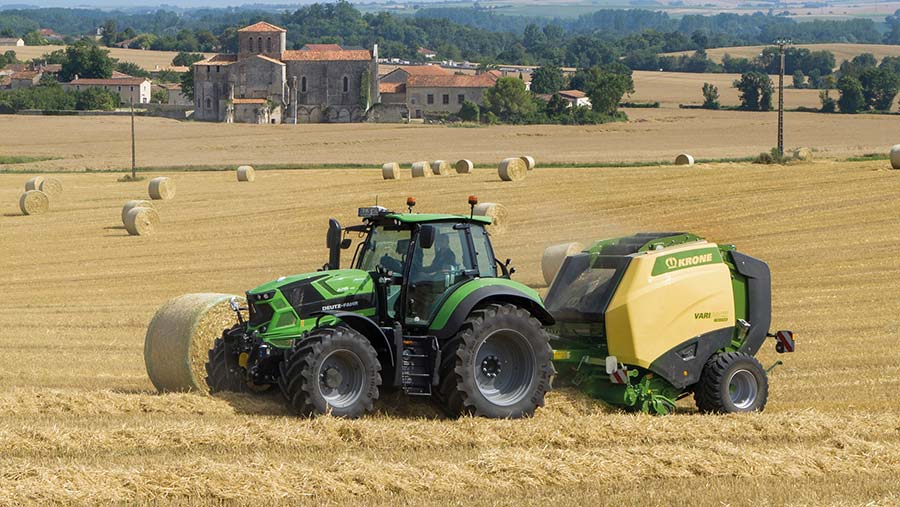 © Deutz Fahr/Krone
© Deutz Fahr/Krone If the idea of driving into a field, punching a few settings into a touchscreen and letting a computer take charge of key tractor and equipment controls sounds a bit far-fetched, think again.
Technology may not be at that level just yet, but it certainly looks increasingly feasible following an agreement among members of the Agricultural Industry Electronics Foundation (AEF).
The agreement establishes international protocols for systems that enable sensor readings from implements to automatically operate tractor controls.
This facility has two main functions:
- To remove repetitive control actions from the operator’s workload, such as the clutch and spool valve sequence involved when operating a round baler
- To help the operator achieve greater productivity through refined speed control when lifting uneven swaths with a baler or forage wagon.
Some operators will view these capabilities as unnecessary at best and as an affront to their experience and skills at worst – but many felt the same about auto-steering until they tried it for themselves, and who would be without it now?
Similarly, automation has been proven to complement the most skilled operator’s abilities.
When auto-powershift was first developed, for example, Massey Ferguson trials demonstrated a potential gain in output as operators were less inclined to shift speeds as frequently.
And, most recently, Claas has demonstrated the benefits of its Cemos auto-control system for combines, and the new Cemos advisory system for tyre pressures, ballast and engine/transmission settings on Axion tractors.
See also: Broadacre spot spraying kits: All you need to know
- How much does automation cost?
- Speed control – balers and forage wagons
- Controlling tractor speed – drilling, spraying and slurry application
- Cutting repetitive baler control functions from workload
- Automation for tillage implements
Improving consistency
Automation is here to stay and will only become more widespread as manufacturers develop systems to positively influence the quality or consistency of field work – precision planting, applying slurry and forming a seed-bed are three that come to mind.
It could also be argued that the automation protocols agreement is another step towards an autonomous future, when driverless tractors and implements would be dispatched to fields while the manager sits in a farm office, monitoring operations remotely.
Automated speed control and spool valve functions controlled by the implement have been around for some time thanks to CNH’s enthusiastic adoption of Class 3 Isobus for Case-IH and New Holland tractors and balers, and also John Deere’s Tractor Implement Automation software.
There are also non-Isobus implement solutions, such as on the Automate version of Kuhn’s FB 3135 round baler with its electrically operated hydraulic valve block.
But manufacturers have been working towards a more comprehensive suite of capabilities.
These include pto on/off and speed control, three-point linkage lift/lower, and tractor transmission stop/start and forward/reverse selection in addition to ground speed.
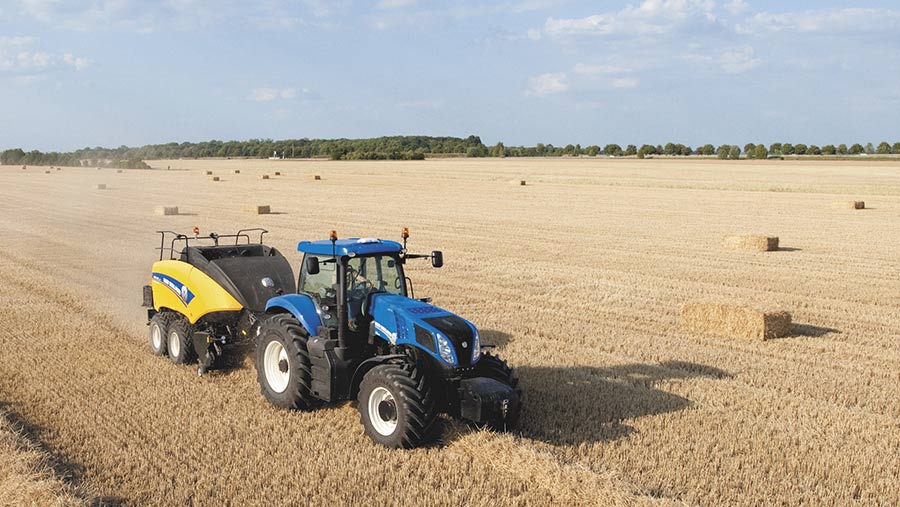
New Holland Intellicruise ground speed management is operated through Class 3 Isobus© New Holland
Health and safety challenges
The main challenge for the AEF working group, it seems, has been to meet concerns not just about the usual technical compatibility between tractors and implements across brands, but more importantly, about the risk, safety and liability implications of software anomalies causing unexpected control operations.
For the new Isobus Tractor Implement Management (TIM) system, it was recognised that compatibility checks needed to go beyond the one-off certification process required for current Isobus functions such as virtual terminal, section control and task control for variable-rate application.
The manufacturer group came up with what it considers is a robust approach by checking compatibility every time a TIM-enabled tractor, implement and control device are connected.
An AEF digital certificate embedded in the manufacturer’s software is checked when the first connection is made between TIM-compliant devices, and a conformance key shared at that point is then checked every time that tractor and implement combination are connected again.
Certified tractors
Following plug-in tests, the first tractor TIM conformance certificates were issued by AEF last year to Deutz-Fahr for its 6- to 9-series TTV stepless transmission tractors and to Kubota for the new Stage 5-compliant M7003-series tractors equipped with the K-Monitor Pro Isobus terminal.
Since then, Claas has successfully completed conformance testing for all Stage 5 tractors, from the Arion 400 to the Xerion 4000 and 5000, and John Deere has earned the qualification for its Tractor Implement Automation feature available on 6M and 6R models.
Other manufacturers are preparing their tractors for TIM capability roll-out while awaiting the outcome of their software and device tests.
Among equipment manufacturers, Krone was first to receive TIM certification, having submitted its new Varipack round balers and the Comprima fixed-chamber balers and baler-wrappers, as well as the Fortima models that are not available in the UK.
Kubota soon followed with the BV 5160 and BV 5200 variable-size balers, and Claas has TIM certification for its Cargos 8000- and 9000-series self-loading forage wagons.
Lemken, meanwhile, has become the first tillage equipment manufacturer to secure an AEF TIM conformance certificate for selected Juwel and Diamant ploughs and its iQblue connect device, which enables Isobus TIM capability to be added to Lemken and other manufacturers’ implements.
How much does automation cost?
The new Isobus TIM system is now being listed in several manufacturers’ price lists as a software option in addition to Class 2 Isobus.
Meanwhile, Case-IH and New Holland continue to offer Class 3 Isobus as an upgrade from the Class 2 level to access automation features on their balers.
Case-IH
Tractors equipped with CVXDrive stepless transmissions in the 110-140hp Vestrum and 125-175hp Maxxum can be specced with regular Class 2 Isobus as a £627 option and it is standard from the 160hp Puma 150 upwards.
Upgrading to Class 3 Isobus to get implement control of tractor speed is priced from £629 to £1,255 across the different models.
The LB square balers need the Feed Rate Control software unlock option at £482 to communicate speed instructions to a tractor equipped with Class 3 Isobus.
Claas
For Isobus on Stage 5 versions of the 90-155hp Arion 400 tractors, Claas charges £525. For the 125-205hp Arion 500 and 600 it is a £500 option on CIS and CIS+ versions, but standard with Cebis spec, plus £530 for a front installation if required.
All Axion and Xerion models come with rear Isobus as standard and the Cebis displays on tractors built from 2020 have Isobus built in.
For earlier Stage 4 Arion and Axion models, an Isobus Universal Terminal software unlock is available at about £480.
Cebis spec is required to be able to add Claas TIM, which is a £460 software unlock option throughout the range, while TIM Speed Control on a Cargos forage wagon costs £1,130, plus £395 for an Isobus cable if the machine is not already connected.
Claas TIM has replaced the firm’s Implement Controls Tractor (ICT) and provides hydraulics and ground speed control on Hexashift (semi-powershift) and Cmatic (stepless) tractors up to 20kph.
Deutz-Fahr
Isobus 2 is available on high-specification fruit and vineyard Deutz-Fahr tractors and also on TTV stepless field tractors from the 126-226hp 6-series, on which it is a £955 option for the rear and £1,455 for front and rear connections.
It is standard across the rest of the range to the 336hp 9-series.
SDF has anticipated Isobus TIM by including all the hardware architecture (switches and wiring) since the Stage 4 models of the 6- and 7-series were introduced in 2016.
Any of these tractors can be updated to use TIM through a dealer-installed software upgrade and an unlock key yet to be priced.
Fendt
Isobus is available only on Power Plus, Profi and Profi Plus versions of Fendt tractors, from the 131-171hp 500 Vario upwards, with a front-end connection available for £580 (less My Fendt adjustment) on the new Gen6 versions of the 700 Vario and 900 Vario.
Variotronic Implement Management (Isobus TIM) is currently available only on top-spec Profi Plus versions, which have Isobus as standard, together with a larger (10.4in) Varioterminal, telemetry, Varioguide steering and the agronomy package, with TIM then costing £361 on a 500 and £411 on a 700, 800 and 900 after My Fendt adjustment, and £611 on a 1000 Vario.
TIM speed control for Tigo XR forage wagons and Rogator 300 trailed sprayers is priced at a little over £1,200.
Krone
AEF-certified TIM functions on the Comprima and Varipack balers is available for £590.
New Holland
The Class 3 Isobus option on T5 Dynamic Command (powershift) and Auto Command (stepless) tractors is £931 and £623 on T7 LWB Auto Command and T8 Genesis models, or £932 on the T8 to include steering control.
The same option is priced £310 on T6 Auto Command and £1,243 on T6 Dynamic Command, T7 SWB Sidewinder, T7 LWB Power Command (full powershift) and T7 Heavy Duty models.
Big Baler Intellicruise is a £450 software unlock.
What is the AEF?
The Agricultural Electronics Industry Foundation, set up in 2008, is an international organisation whose members comprise manufacturers of farm equipment, components, digital data platforms and related businesses.
It provides resources and know-how for the increased use of electronic and electrical systems in farming, and is made up of working groups formed from the members’ engineering teams to prepare common standards and protocols for software functionality and physical components such as connectors and cabling.
The AEF’s first task was to create Isobus – the brand name for the digital communications protocol enabling tractor and implement electronic systems to talk to each other using a consistent language. It also provides a common format for the displays increasingly seen in the cabs of tractors and other self-propelled farm machines.
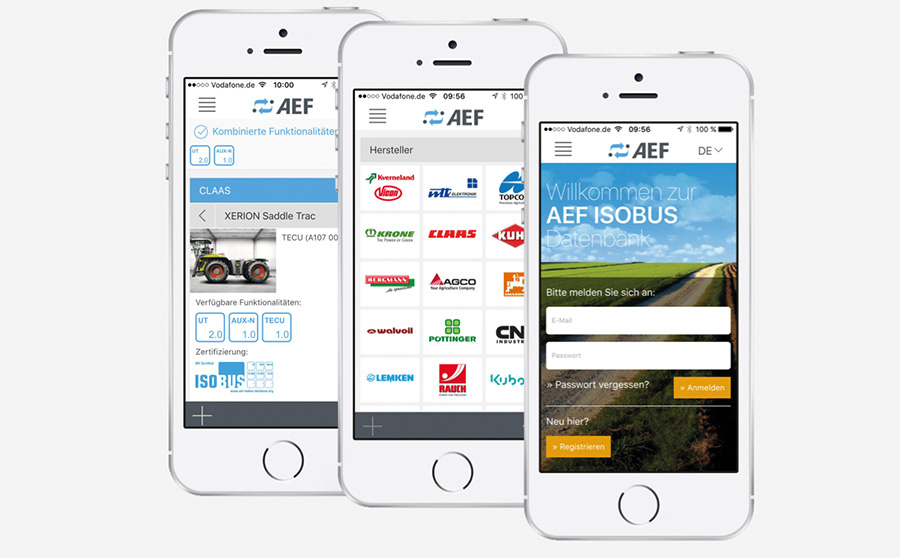
The AEF’s Isobus database provides checks on tractor, implement and device compatibility © AEF
Regular Isobus compatibility testing and certification is another key role of the AEF, whose database (aef-isobus-database.org) can be used by manufacturers and dealers to download software updates and by farmers and contractors to cross-check tractor, implement and device compatibility.
The AEF’s remit has been expanded to include standards for electric drives, cameras, farm management information systems, high-speed Isobus and wireless in-field communication.
Speed control for optimum output and consistency
Just as automatic steering makes tractor operations less tiring and more productive, so auto speed regulation can do the same, say manufacturers offering this facility.
It’s an Isobus function that clearly suits the infinitely variable-speed of a tractor equipped with a stepless transmission – although it is available on some powershift-equipped tractors too – and requires a higher-spec Isobus version with two-way data exchange between the tractor and implement.
CNH Industrial was among the first to embrace this concept with Class 3 Isobus and exploits it on Case-IH and New Holland big square balers.
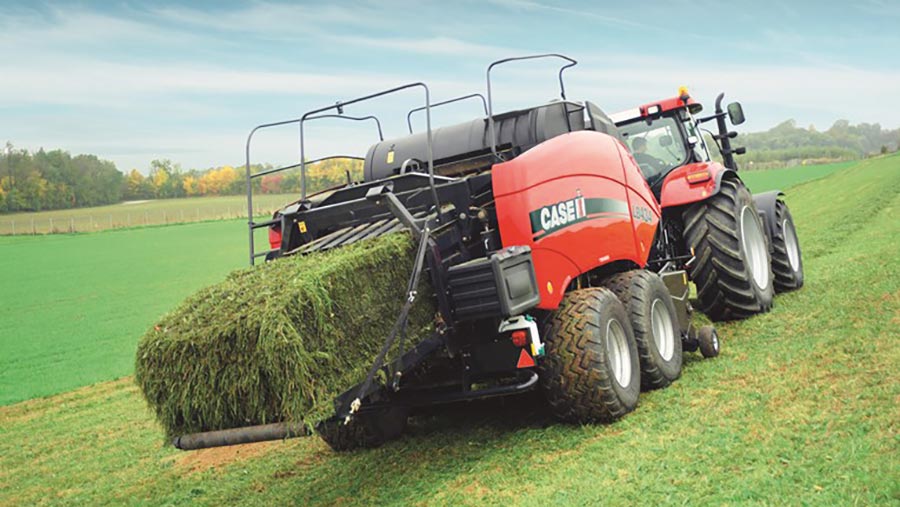
Feed Rate Control on Case-IH LB big balers adjusts forward speed to maintain peak intake rates along variable swaths © Case-IH
Intellicruise for the New Holland Big Baler machines draws data from sensor paddles to measure the crop volume being fed into the stuffer feeder channel, and the time taken to fill this pre-compression chamber.
Rapid calculations then instruct the tractor to speed up or slow down to maintain the target intake value, with comparative tests showing this speed optimisation tech will deliver up to 9% more output and 4% fuel savings.
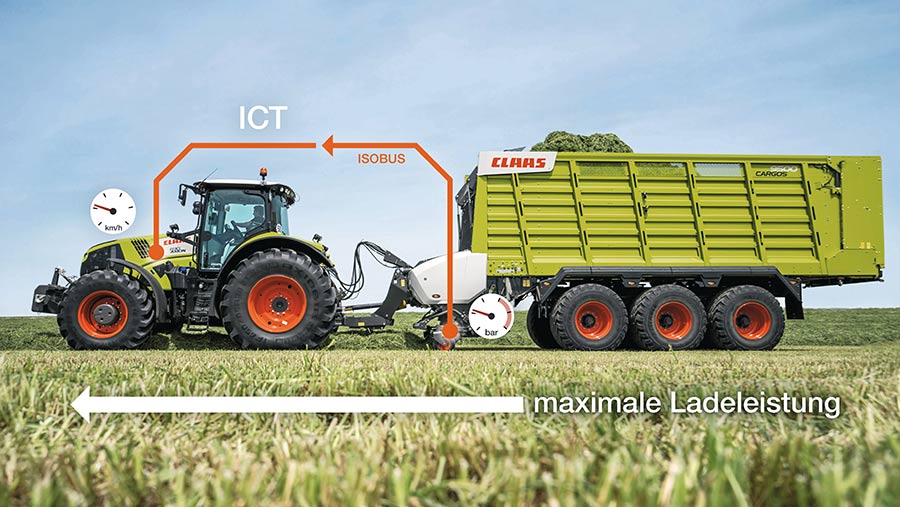
TIM Speed Control for Claas Cargos forage wagons can be used with any Isobus TIM equipped tractor © Claas
The equivalent feed rate control on Case-IH LB balers can do the same, along with the second mode (available whether or not crop slicing is installed) that varies forward speed to produce the preferred number of slices in each bale.
Optimum output is also the purpose of Claas TIM Speed Control for the Cargos 8000- and 9000-series self-loading forage wagons and Fendt’s TIM system for the Tigo XR wagons.
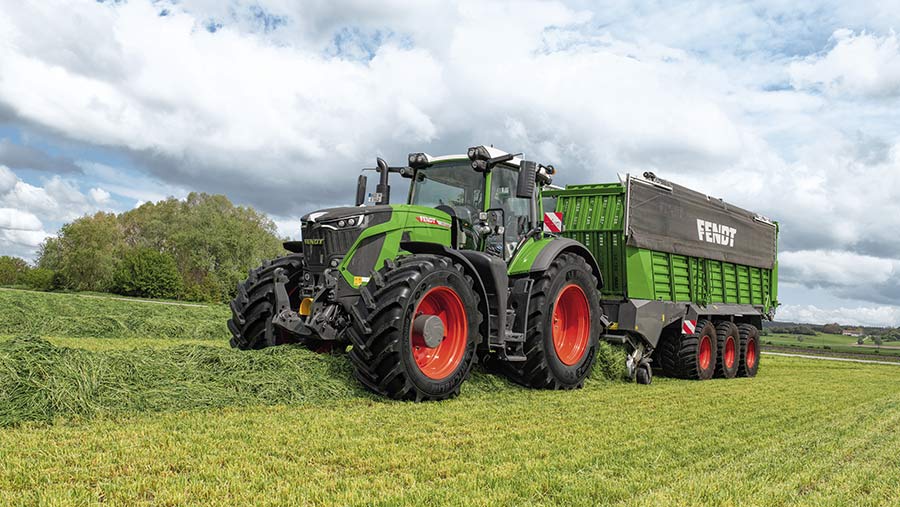
Fendt is rolling out the new Isobus Tractor Implement Management function across its Vario tractors © Fendt
Both use a similar approach, measuring torque at the pick-up in the Tigo’s case and at the pick-up and intake rotor of the Cargos models.
Measurements sent from an ECU on the machine to the Isobus software on the tractor are used to adjust working speed for optimum loading along uneven swaths, without the operator having to intervene.
Controlling tractor speed to maintain work quality
In situations where working speed must be tempered to maintain the quality of the job being done, machines need to measure more than just a load factor when taking control of the tractor’s transmission.
Take, for example, the Autospeed function devised by Horsch for its Maestro precision planters when controlled through the E-Manager Midi Isobus console. The priority is to help operators exploit the fast working speed potential of the Maestro’s electrically driven planting units while protecting seed placement consistency.
At present, it works with John Deere’s Tractor Implement Automation (TIA) software option, available on 6R tractors that are at least Greenstar and Autotrac guidance ready.
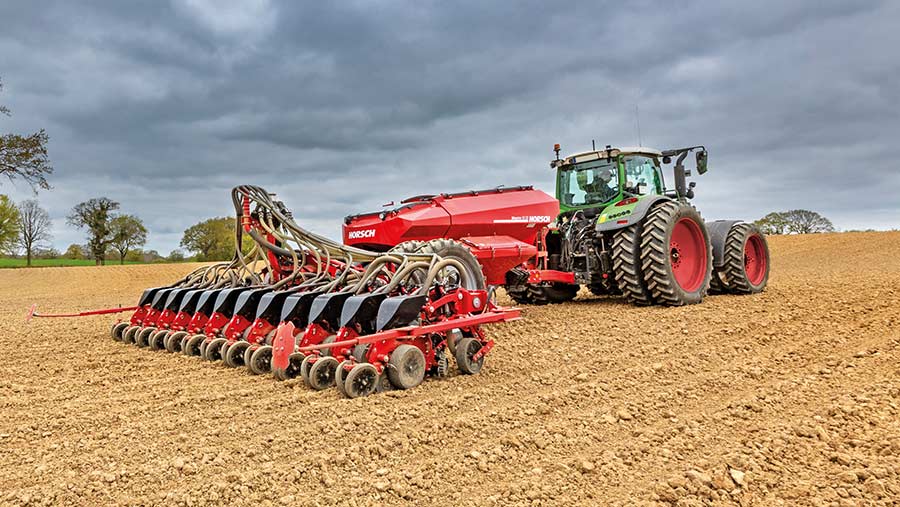
AutoSpeed for Horsch Maestro precision planters aims to achieve the optimum working speed for output with reliable seed spacing © Horsch
First off, the operator sets the required seed spacing and a permitted variation value; then, when the planter gets under way, an optical sensor on each downpipe counts the number of seeds and records misses and doubles.
This enables the software to calculate a variation coefficient. If that coefficient strays beyond the permitted variation value, either above or below the target, the controller signals the tractor to slow down or speed up.
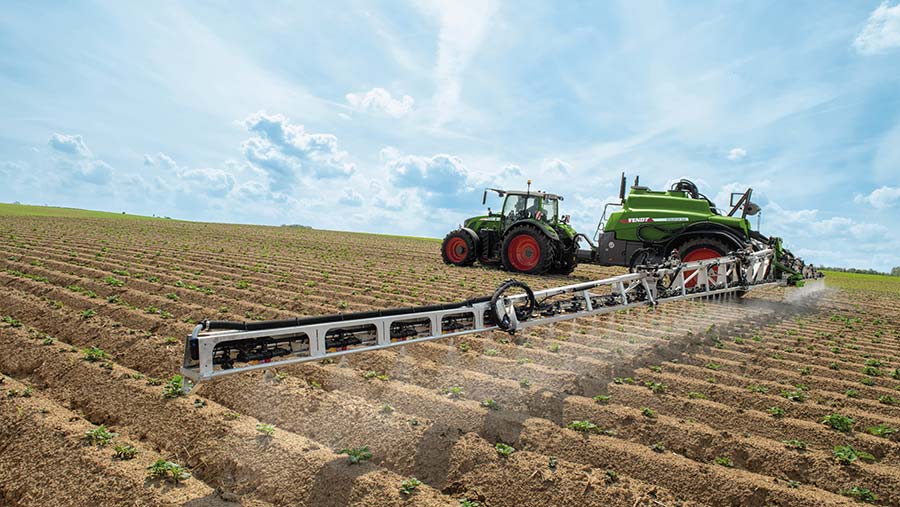
Working speed regulation via TIM for Fendt Rogator 300 series sprayers aims to keep nozzles working at optimum pressure for maximum drift control © Fendt
Drift control
Maintaining effective drift control is the objective of Fendt’s TIM Isobus software application for Rogator trailed sprayers, especially when using the Optinozzle automatic nozzle-switching technology.
The latter allows greater speed variation while achieving the required application rate and staying within spray tip pressure limits by selecting either individual nozzles or combinations from a cluster of three or four nozzles.
The TIM function – a £1,244 option – fine-tunes this process by automatically dialling in the optimum forward speed for each nozzle selection to maintain the system pressure that produces the best drift control performance.
For nutrient application rate control, John Deere’s TIA feature can be used with slurry and digestate tankers equipped with the company’s near-infrared sensor.
In standard form, Deere’s Manure Sensing system uses the near-infrared technology to measure key ingredients in slurry and then adjust the output flow to hit an application rate target.
But with a TIA software-equipped 6R-series tractor, the rate is achieved at full flow by automatically adjusting the speed of the outfit.
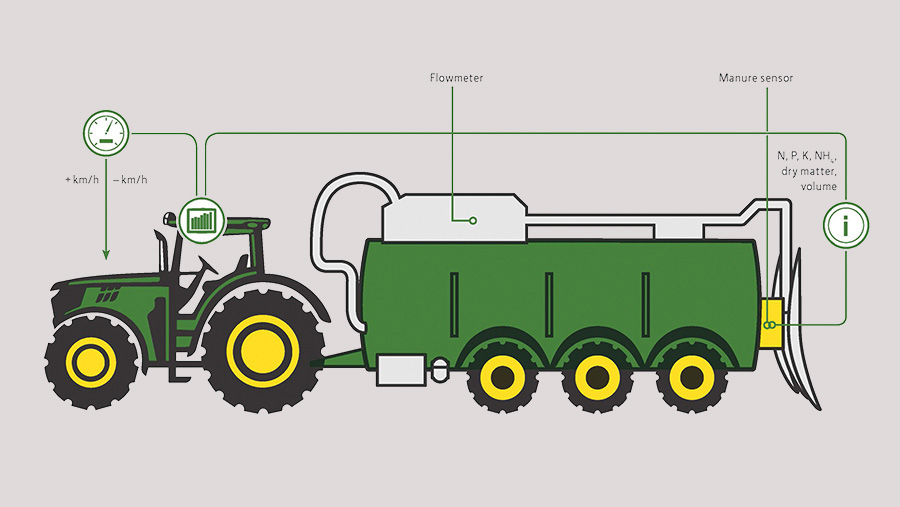
Connecting John Deere’s manure-sensing system to a 6R-series with Tractor Implement Automation allows the tanker to operate at full flow with application rate regulated by automatic tractor speed adjustment © John Deere
Cutting repetitive baler control functions from the workload
With a frequent series of control inputs needed to complete each bale, the round baler is an obvious choice for some degree of automation.
Reducing fatigue by easing an operator’s mental workload is the main benefit of the technology, but implement manufacturers say automation can also help bale consistency over a long working day and achieve greater outputs that reduce costs.
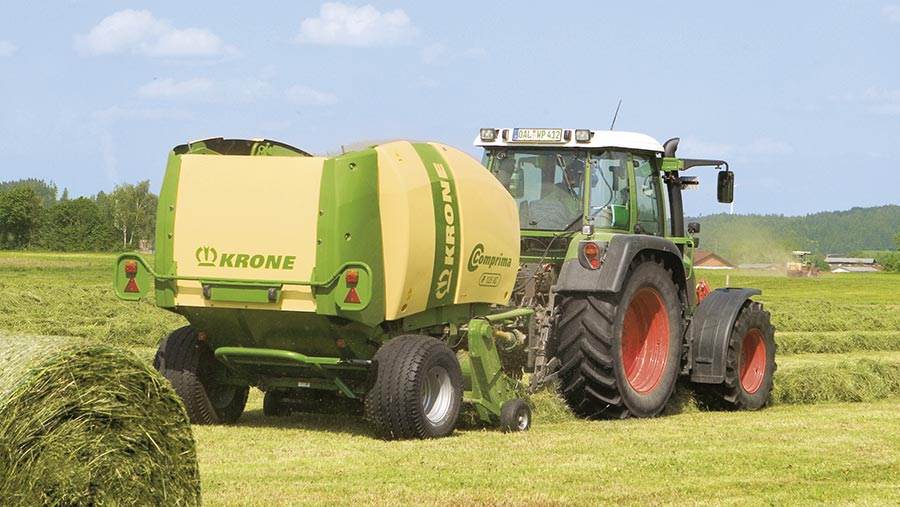
Auto chamber open/close is a feature of Krone Comprima balers when connected to a tractor’s Isobus system with TIM capability © Krone
Class 3 Isobus is used for New Holland’s Intellibale control system for Roll-Belt 150 and 180 balers, which automatically stops the tractor, wraps and discharges the bale, closes the door and signals the driver to press the guidance button to move off again.
Kubota was the first manufacturer to have both a tractor and an implement successfully complete the AEF Isobus TIM conformance test – the new M7003-series tractor in Premium spec form with the KVT stepless transmission, and the BV 5160 and BV 5200 variable-chamber round balers.
For now, Kubota’s TIM software, which requires an unlock key purchased for the K-Monitor Isobus terminal, is limited to automatically opening and closing the tailgate.
But further functions are anticipated that will have a more significant effect on the operator’s workload.
Completing a round bale under manual control involves as many as 10 steps, the company points out.
In future, with spool valve operation, stopping the tractor and engine speed all automated, that sequence would be reduced to just three steps for the operator to handle.
By taking out the repetitive tasks associated with round baling, the company expects to see a reduction in operator fatigue, while overall efficiency and quality will improve.
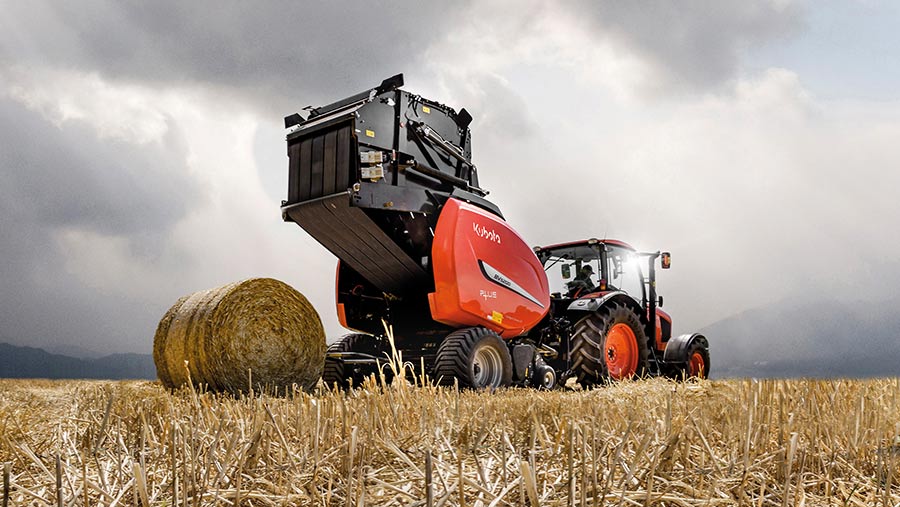
Kubota has secured Isobus TIM recognition for its BV 5200 round baler © Kubota
Adding to the options
Krone also sees further functions being added to the tailgate opening and closing available under Isobus TIM control for the three baler product lines it has had conformance-tested.
These are the Comprima F 125 and F 155 fixed-bale-size machines and their CV baler-wrapper counterparts; the new Varipack V 165 and V 190 variable-chamber balers; and the Fortima balers, which are no longer available in the UK.
Operate a McHale F5600 fixed-chamber baler and the machine will also open and close the tailgate automatically, as will a modern Claas Rollant baler once the netting sequence is complete.
Comfort automation on the Claas Variant variable-bale-size machines goes further, by adding a knife-cleaning cycle, knife retraction before the final layers of the bale are picked up and blockage clearance to auto chamber opening and closing.
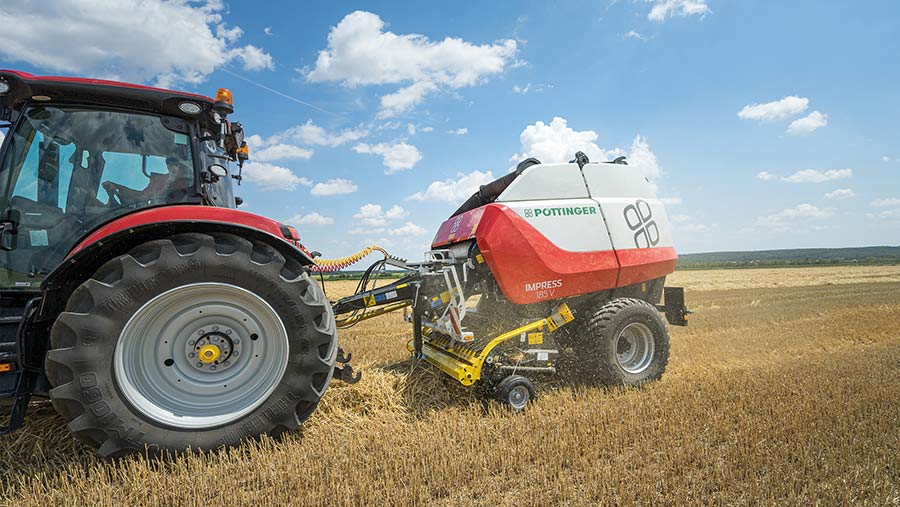
In addition to opening and closing the bale chamber, the Pottinger Impress will lift the pick-up reel when the ‘bale finished’ signal is given © Pottinger
Pro versions of the Impress round balers from Pottinger will also lift the tailgate and – as long as the bale kicker option is fitted – close it once the bale is successfully discharged.
As well as that, the Impress also lifts the pick-up reel, triggered as soon as the “chamber full” signal is sounded, to give the operator one less thing to do.
Auto tailgate open and close using Tractor Baler Automation software features on JD F441R fixed-chamber and V451R and V461R variable-chamber balers as standard, with an upgrade available for earlier 900-series machines going back to 2012.
If the 6R tractor used to operate these machines is at least Greenstar and Autotrac guidance ready, and has Tractor Implement Automation via the Isobus connection, then the system will bring the outfit to a halt for net wrapping.
That also goes for the New Holland Roll-Belt 150 and 180 variable-bale-size machines when operated by Class 3 Isobus-equipped tractors, which includes the New Holland models mentioned on p88 when equipped with Sidewinder II armrest consoles.
Speed variation along uneven swaths, plus automatic net-wrapping initiation and chamber open/close, are also covered.
Automation without Isobus TIM
Kuhn has taken a non-Isobus approach for the Automate version of its FB 3135 Opticut 1.25m baler, even though a number of control functions are operated using Isobus.
In this instance, sensors and a hydraulic valve block on the baler operate automatic chamber open and close, with the bale kicker signalling when the bale is clear.
This stops the tailgate lifting any further than it needs to, saving precious seconds that Kuhn says add up to minutes of extra work time over a large field.
Another automated feature lowers the drop-floor when a blockage occurs, ready for the operator to re-engage drive to the feed rotor to clear the way.
And the driver can set a pre-determined number of bale roll-ups to trigger a cleaning sequence that maintains the effectiveness of the crop-slicing knives.
Operators of the FB 3135 Opticut Automate can choose to use these functions – which add £2,830 to the standard machine – or switch to a semi-manual mode that requires a confirmation button press, or turn off the auto features altogether.
Automation for tillage implements
Lemken is pioneering the adoption of “smart tillage” for soil-working implements with an AEF-certified device that links a cultivator or plough to a tractor equipped with Isobus TIM.
The iQblue connect unit, available from October this year, can be used with sensors attached to new or existing implements and incorporates a GPS receiver and mobile data connection for wireless communication with farm management systems, for example.
For ploughs, such as Lemken’s own AEF-certified Juwel 8 MV and 10 MV mounted and Diamant 16 V semi-mounted implements, the iQblue connect unit enables automatic operation of a tractor’s spool valve to adjust working width.
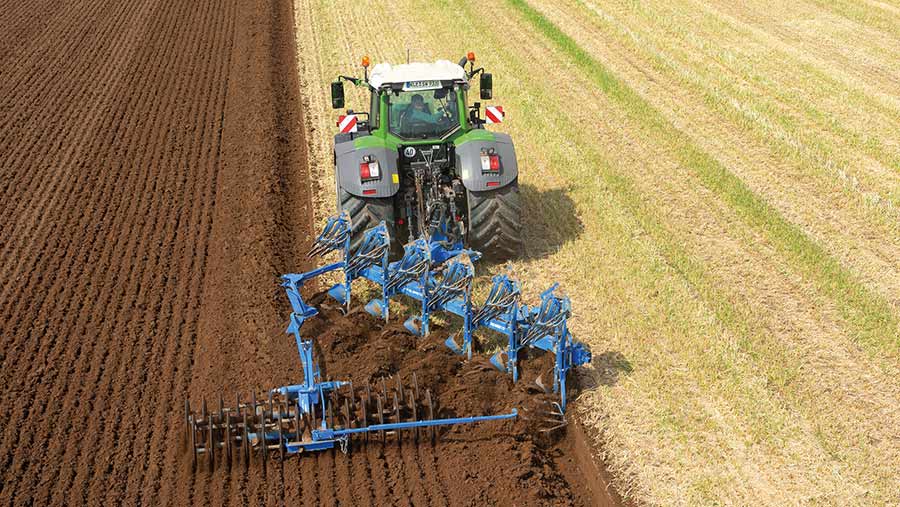
On Lemken ploughs with hydraulic width adjustment, the iQblue unit can tap into a tractor’s Isobus TIM system © Lemken
This would ensure that the plough always produces a precise and straight furrow and allows operators to accurately work towards a target furrow when working in a wedge-shaped field.
Adding a working depth sensor to a semi-mounted cultivator enables TIM control of the tractor’s hydraulics via the iQblue connect system for variable-depth tillage based on a digital map.
In fields where there are different soil types or compaction zones, adjusting cultivation depth can make noticeable savings in power requirement and consequent fuel consumption.
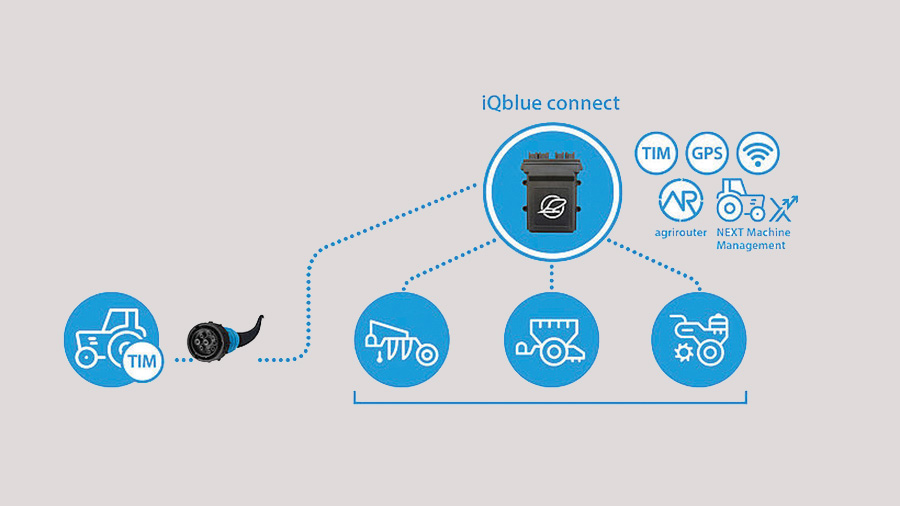
The universal iQblue connect device provides a connection from any tillage device to the tractor, enabling features such as variable-depth cultivation based on a digital map © Lemken
Seed-bed quality
Pottinger has looked at seed-bed quality as part of its assessment of the potential for exploiting “implement-controlling tractor” technology for tillage work and produced a prototype system that works with Class 3 Isobus.
From trials, the company concluded it would be both feasible and valuable to evaluate seed-beds as they are made and adjust the cultivator and working speed accordingly.
Pottinger proposes an optical monitoring system for its Lion power-harrow-based drill combinations that assesses the coarseness of the seed-bed in real time.
The control system would then be used to alter the pto speed and working speed of the tractor, with the aim of achieving a target seed-bed quality across different soil types and in different conditions.
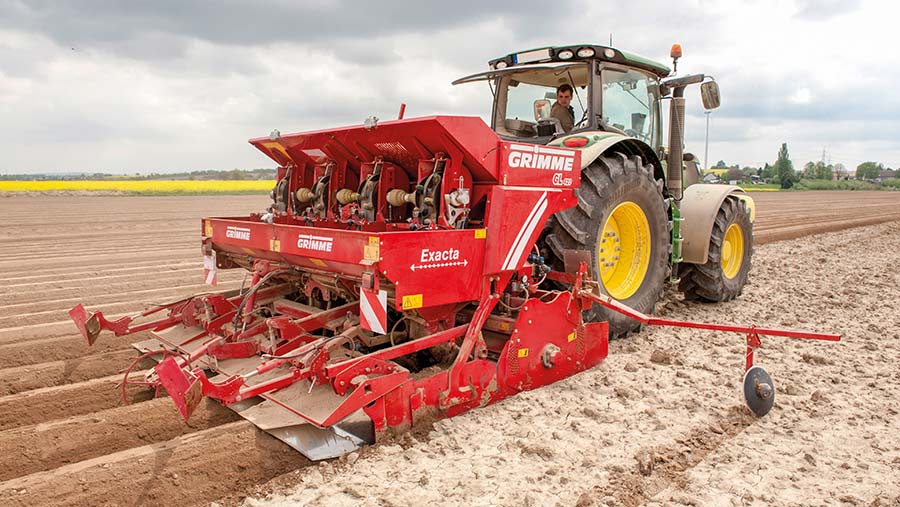
Grimme’s Hitch Control system aims to regulate working depth and the pressure on the ridge-forming hood of a GL Exacta planter-tiller combination © Grimme
The company cites optimum sowing conditions, the potential to avoid overcultivation, and the ability to work at night while achieving consistent results, as some of the benefits.
However, the current system is not compatible with AEF’s TIM protocol, and the level of interest means the project is on ice for the time being.
Grimme’s work on tillage implements has resulted in Hitch Control as part of its Potato Suite digital technologies.
This automatically regulates the pressure applied to the ridge-forming hoods on a four-row GL 420 Exacta planter-tiller or planter/power-harrow combination.
It controls the working depth of the two elements via the tractor’s rear lift arms through the Isobus TIM function and aims to produce consistently well-shaped ridges while potentially saving fuel and relieving the driver from making repeated adjustments.

